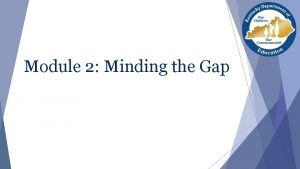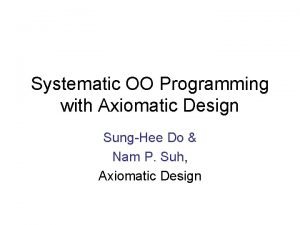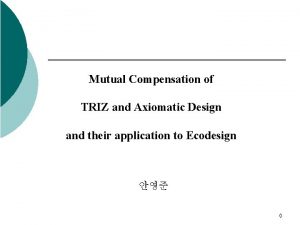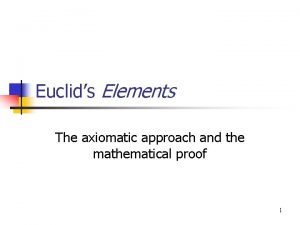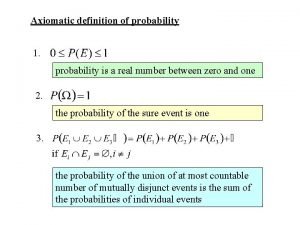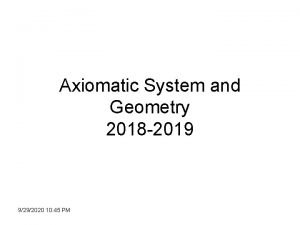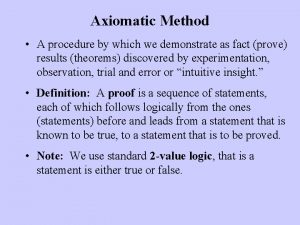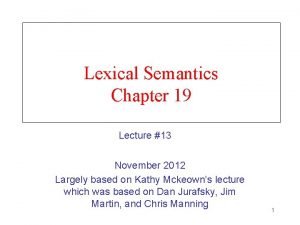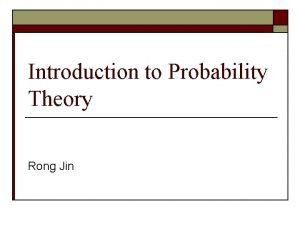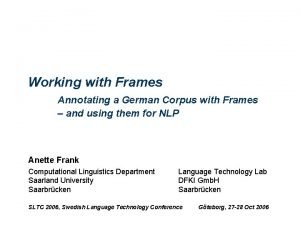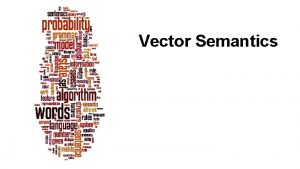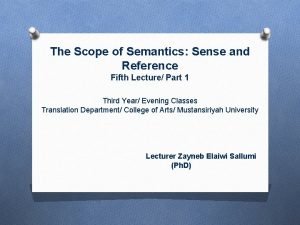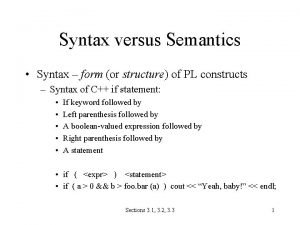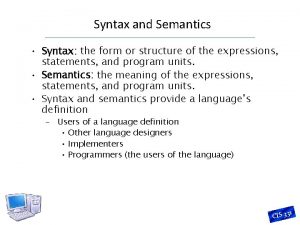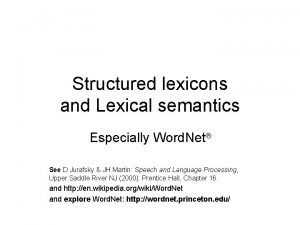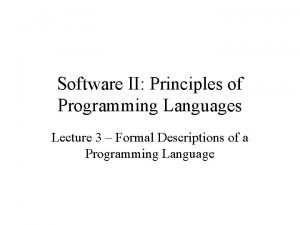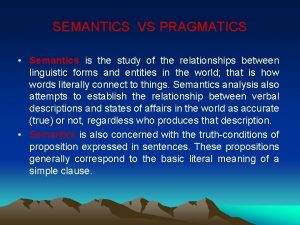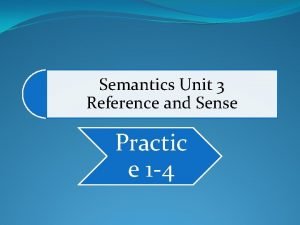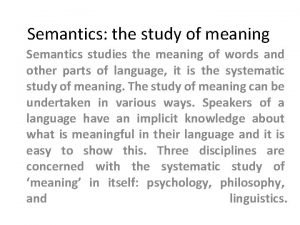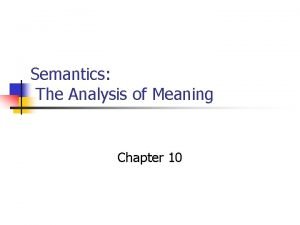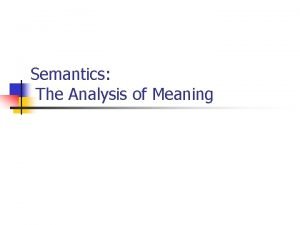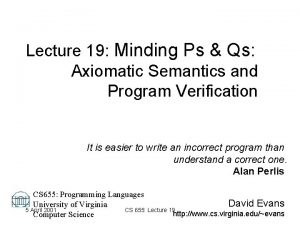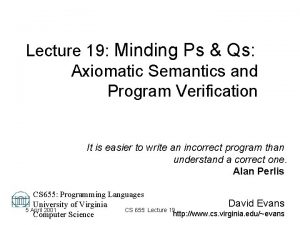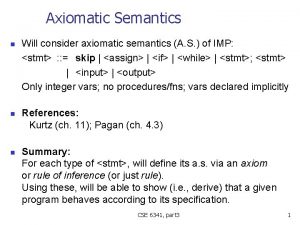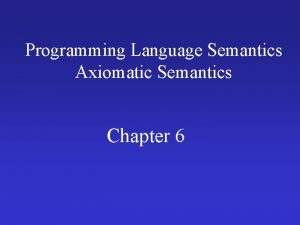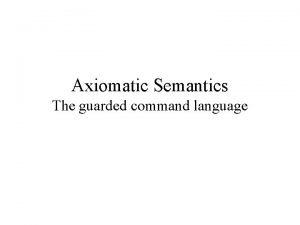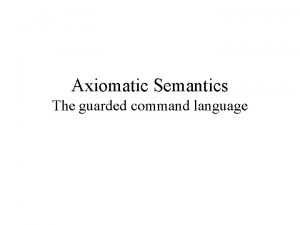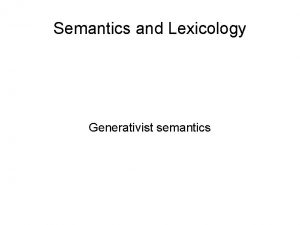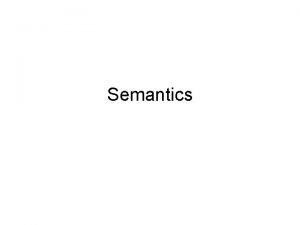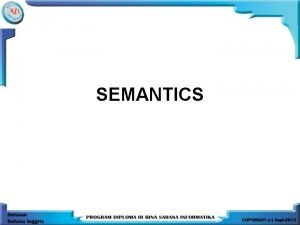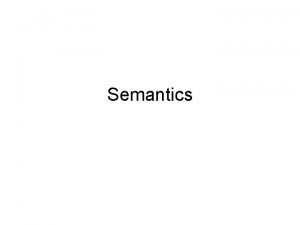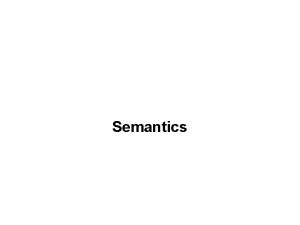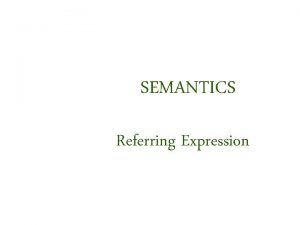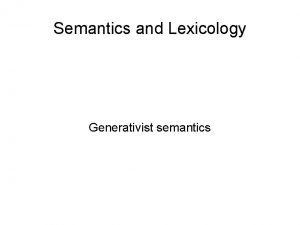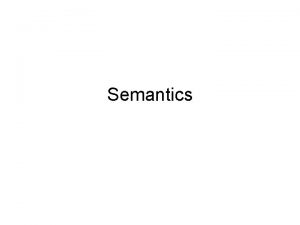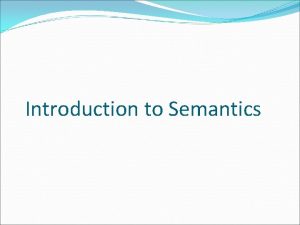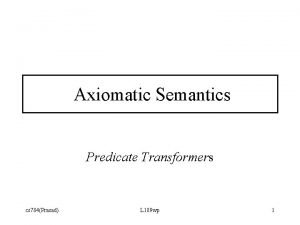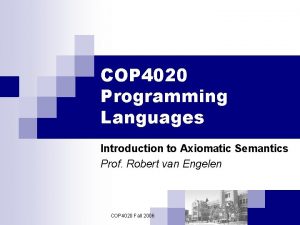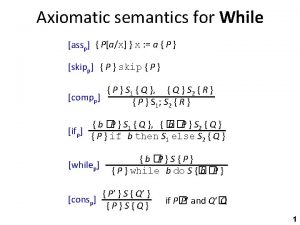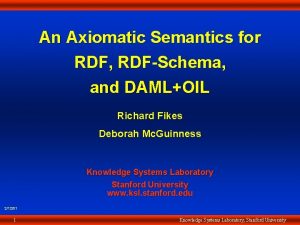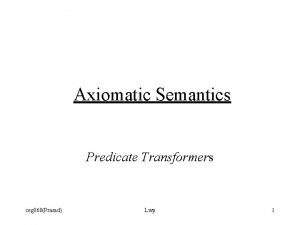Lecture 12 Minding your Ps Qs Axiomatic Semantics


























- Slides: 26

Lecture 12: Minding your Ps & Qs: Axiomatic Semantics and Program Verification It is easier to write an incorrect program than understand a correct one. Alan Perlis CS 655: Programming Languages David Evans University of Virginia CS 655 http: //www. cs. virginia. edu/~evans Computer Science

Menu • Position Paper 3 Results • Axiomatic Semantics • Program Verification 9/10/2020 University of Virginia CS 655 2

Position Paper 3 • Average on Position Paper 3 = 1. 04 • Good papers with 3 different answers: – Yes, they should have started with CLU – No, CLU wouldn’t have helped much because of different requirements – Its a silly question – of course they looked at and were influenced by CLU • Two interpretations of requirements – General goals: high-level language for programming reliable embedded systems – Specific goals: specific language requirements set out in STEELMAN, etc. – Best: analyze the specific requirements in terms of the general ones • Be resourceful: easy way to get “check++” on this position paper 9/10/2020 University of Virginia CS 655 3

From: Barbara Liskov <liskov@piano. lcs. mit. edu> Subject: Re: CLU and Ada To: evans@cs. virginia. edu Date: Fri, 4 Feb 2000 13: 38: 45 -0500 (EST) Actually CLU was known at the time the initial work on Ada happened and so was Alphard (this was Bill Wulf's language). Both Bill and I were at the preliminary meetings on Ada and both of us worked as consultants in various ways. The requirements for Ada were larger than what CLU provided. In particular there were requirements for concurrency, for fixed point arithmetic, and even maybe real-time processing (I can't remember about this). And certainly at that point there was a requirement for explicit storage management! In fact, my recollection was that the requirements were a huge problem. They were tremendously over constrained, with reqs for very specific solutions. This by itself was enough to lead to a convoluted design. Of course we are talking about politics here: how this particular set of requirements came to be accepted as defining what had to be done. 9/10/2020 University of Virginia CS 655 4

It is probably still possible to get the original requirements documents (the "Strawman", "Tinman", etc. ) You might also look at the book on history of programming languages. Another point is that many of the issues that caused design problems at the time were more difficult then than they are now, since programming languages are much better understood. This is partly the reason why the requirements were not what they should have been, and also partly why the solutions in the language were more complex than necessary. But of course there was also "not invented here" problems. And because the whole project was structured in a way that effectively prevented the best language designers from doing the design, the obvious thing happened. b 9/10/2020 University of Virginia CS 655 5

Date: 4 Feb 2000 13: 08: 15 -0500 Pick a good time: From: David Evans <evans@cs. virginia. edu> for most academics: early afternoon (Friday best) To: liskov@lcs. mit. edu for industrial types: mid-week mornings (? ) Subject: CLU and Ada Don’t wait until you are up against a deadline. Professor Liskov, Introduce yourself and context. 2 sentences! I'm teaching the graduate programming languages course at UVA this term, and week after next we'll be focusing mostly on CLU. I plan to assign to the students the task of writing position papers on whether or not developing Ada was necessary in light of what had already been done with CLU. To me it seems extremely unnecessary, as nearly every feature of Ada was done in a more principled way in CLU. Do you know if the Ada committees were aware of CLU and considered it? It seems reasonable that it wasn't on the list of languages they Flattery considered in 1976, but shocking if they weren't aware of it when they started the language design contracts in 1977 in light of what had already been published about CLU at this time. Are you aware of any technical or political reasons why they felt the need to design a new language? Ask a pointed question – but do your homework first (better than I did). Best regards, All project groups should be Dave <signature with URL removed> emailing experts onemail your and topic. 9/10/2020 University of Virginia CS 655 6

Axiomatic Semantics • Reason about programs using axioms (mathematical rules about program text fragments) • What’s wrong with operational semantics? – Limited deductive power (simulates a particular execution) – Depends on understanding of virtual machine • What’s wrong with static semantics? – Limited to simple properties • Axiomatic: prove more interesting properties about programs without simulating executions 9/10/2020 University of Virginia CS 655 7

Floyd-Hoare Rules pre-condition post-condition P { code fragment } Q Partial correctness: For all execution states which satisfy P, if the code fragment terminates, the resulting execution state satisfies Q. Total correctness: For all execution states which satisfy P, the code fragment terminates and the resulting execution state satisfies Q. (Sometimes people write: P [ code fragment ] Q. ) 9/10/2020 University of Virginia CS 655 8

A simple example { true } while true do x : = 1 { 2 + 2 = 5 } Partial correctness: Yes! Since code doesn’t terminate, any post-condition is satisfied. Total correctness: No! Since code doesn’t terminate, no total correctness post-condition could be satisfied. 9/10/2020 University of Virginia CS 655 9

A Toy Language: Algorel Program : : = Statement : : = Variable : = Expression | Statement ; Statement | while Pred do Statement end Expression : : = Variable | Int. Literal | Expression + Expression | Expression * Expression Pred : : = true | false | Expression <= Expression Why not use BARK? 9/10/2020 University of Virginia CS 655 10

An Algorel Program Fragment while n <= x do result : = result * n; n : = n + 1; end % Post-condition: result = x! 9/10/2020 University of Virginia CS 655 11

Goal: find weakest pre-condition P & x 0 = x { while n <= x do result : = result * n; n : = n + 1 end } result = x 0! Elevator speech: group 3 9/10/2020 University of Virginia CS 655 12

Rule for while P Inv, Inv { Pred } Inv, Inv & Pred { Statement } Inv, (Inv & ~Pred) Q, while Pred do Statement end terminates P { while Pred do Statement end } Q 9/10/2020 University of Virginia CS 655 13

What can go wrong? • Invariant too weak – Can’t prove (Inv & ~Pred) Q • Invariant too strong – Can’t prove Inv & Pred { Statement } Inv – Can’t prove P Inv (for sufficiently weak P) 9/10/2020 University of Virginia CS 655 14

Go backwards: Inv & ~Pred Q Inv & ~(n <= x) result = x 0! Guess an Invariant: Inv = result = (n - 1)! & x = x 0 & n <= x + 1 Inv & ~(n <= x) result = x 0! n <= x + 1 & ~(n <= x) n = x + 1 result = ((x + 1) – 1)! result = x! x = x 0 result = x 0! 9/10/2020 University of Virginia CS 655 15

Inv & Pred { Statement } Inv result = (n - 1)! & x = x 0 & n <= x + 1 & n <= x { result : = result * n; n : = n + 1; } result = (n - 1)! & x = x 0 & n <= x + 1 Rule for sequences: { A } s 0 { B }, { B } s 1 { C } { A } s 0 ; s 1 { C } 9/10/2020 University of Virginia CS 655 16

Push: result : = result * n result 0 = result & result = (n - 1)! & x = x 0 & n <= x + 1 & n <= x { result : = result * n } B Substitute result = result 0 * n: B = result = (n – 1)! * n & rest is same B = result = n! & rest is same 9/10/2020 University of Virginia CS 655 17

Reminder: Inv = result = (n - 1)! & x = x 0 & n <= x + 1 Push: n : = n + 1 n 0 = n & result = n 0! & x = x 0 & n 0 <= x + 1 & n 0 <= x { n : = n + 1 } Q Substitute n = n 0 + 1 (n 0= n – 1) : result = (n – 1)! & x = x 0 & (n – 1) <= x + 1 & (n – 1) <= x result = (n – 1)! & x = x 0 & n <= x + 2 & n <= x + 1 result = (n – 1)! & x = x 0 & n <= x + 1 Inv 9/10/2020 University of Virginia CS 655 18

Progress Checklist We need to pick P to make this work. P Inv, Inv { Pred } Inv, Trivial since Pred = (n <= x) Inv & Pred { Statement } Inv, (Inv & ~Pred) Q, while Pred do Statement end terminates P { while Pred do Statement end } Q 9/10/2020 University of Virginia CS 655 19

Find weakest pre-condition • Need to show P & x = x 0 result = (n - 1)! & x = x 0 & n <= x + 1 • Weakest: P = result = (n – 1)! & n <= x + 1 • More intuitive (but stronger): P = result = 1 & n = 0 & x >= 0 result = 0! & n <= x + 1 Inv 9/10/2020 University of Virginia CS 655 20

What have we proved? Partial correctness of: result = 1 & n = 0 & x >= 0 & x 0 = x { while n <= x do result : = result * n; n : = n + 1 end } result = x 0! 9/10/2020 University of Virginia CS 655 21

Total Correctness: Must show termination also 1. Define an energy function, E integer 2. Show P E is finite, non-negative 3. Show Pred does not change E 4. Show loop body decreases E e 0 = E & Pred { Statement } E < e 0 5. Show E = 0 ~Pred (termination) Remind you of anything? 9/10/2020 University of Virginia CS 655 22

Termination Proof 1. Energy Function E=x+1–n 2. P E is finite, non-negative n = 0 & x >= 0 E = x + 1 – 0 x is >= 0, so x + 1 is finite, non-negative 3. Pred does not change E Trivial, Pred is n <= x 9/10/2020 University of Virginia CS 655 23

Termination Proof, Part 2 4. Show loop body decreases E e 0 = x + 1 – n & n <= x & n 0 = n {result : = result * n; n : = n + 1; } x + 1 - n < e 0 True: x + 1 – (n 0 + 1) < x + 1 - n 0. 5. Show termination: x + 1 - n = 0 ~(n <= x) x + 1 = n ~(x + 1 <= x) 9/10/2020 University of Virginia CS 655 24

Summary • Once you have the right invariant, proving partial correctness is tedious but easy – Computers can do this quickly • Picking the right invariant is hard and not well understood – Computers can do this slowly in special circumstances, often need help (from programmer or language designer) • Next time: Proof-Carrying Code – Can quickly and automatically prove interesting properties (type safety, memory safety, etc. ) about arbitrary code if you are given the right invariants 9/10/2020 University of Virginia CS 655 25

Charge • Rest/catch up on your other classes – Unless you are prosecution attorney • Only one paper to read (Necula & Lee) • Nothing to write until March 23 (preliminary project report) – Except for attorneys • Keep making progress on your projects (especially if you won’t during Spring Break) 9/10/2020 University of Virginia CS 655 26
 Minding the gap introduction
Minding the gap introduction Compare procedural semantics and declarative semantics.
Compare procedural semantics and declarative semantics. 01:640:244 lecture notes - lecture 15: plat, idah, farad
01:640:244 lecture notes - lecture 15: plat, idah, farad Axiomatic design example
Axiomatic design example Systematic oo
Systematic oo Define axiomatic system
Define axiomatic system Axiomatic design
Axiomatic design The axiomatic method
The axiomatic method Axiomatic probability formula
Axiomatic probability formula Axiomatic system of geometry
Axiomatic system of geometry Definition in an axiomatic system
Definition in an axiomatic system Axiomatic antonym
Axiomatic antonym Axiomatic definition of probability
Axiomatic definition of probability Give us your hungry your tired your poor
Give us your hungry your tired your poor Frame semantics
Frame semantics Vector semantics
Vector semantics Scope of semantics
Scope of semantics Semantics syntax
Semantics syntax Syntax vs semantics
Syntax vs semantics Lexicon antonym
Lexicon antonym Parse tree for if else statement
Parse tree for if else statement Difference between semantics and pragmatics
Difference between semantics and pragmatics Constant and variable reference in semantics
Constant and variable reference in semantics What does semantics study
What does semantics study Polysemy examples
Polysemy examples Semantics roles
Semantics roles 10 examples of polysemy
10 examples of polysemy
